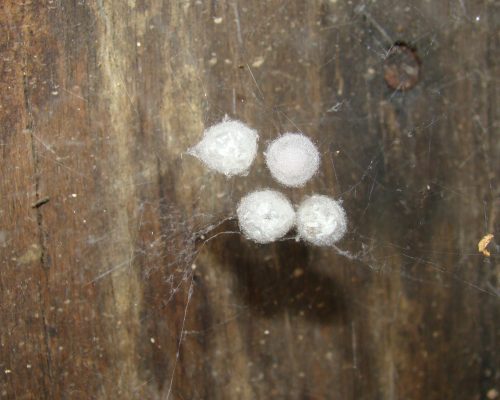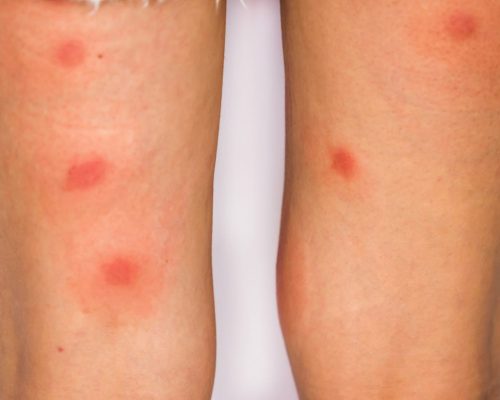But you’re not sure you have an infestation.
If you’re looking for common signs of spider infestation, you’ve come to the right place.
Here, we’ll go over five common signs of spider infestation and how to get rid of them.
Signs of Spider Infestations
1. Live Spiders
Seeing one or two live spiders in your home doesn’t necessarily mean you have an infestation.
If you continuously see spiders outside and inside your home – this is a more impactful sign that you have a spider infestation.
Consistently seeing spiders may be a sign that they are mating and reproducing.
Spider infestations can take place mostly outdoors. Over time, the spiders will migrate and grow their population indoors.
2. Egg Sacs

Seeing spider egg cases is another strong indication of an infestation. Their presence means the spiders are reproducing in your home.
These are small round balls made of silk.
The most common spider egg sac is white or tan. It’s round and has either a smooth or spiked texture.
Spiders usually hide their egg sacs well. But the best places to find them are in dark, undisturbed areas in your home.
Typical places to look for spider egg cases are on spider webs, tree bark, under kitchen and cabinet sinks, and woodpiles.
Spider eggs are problematic for two reasons.
First, they indicate that there are now likely several hundred spider eggs ready to hatch in your home.
Two, a female can lay one egg sac every one to two months. This means she’s likely to continue producing eggs unless dealt with.
3. Flying Insects
Spiders like to feast on flying insects.
Their diet is why you’ll commonly find spider webs set up high in corners of ceilings or near light sources.
If you have lots of mosquitoes, flies, or gnats flying about, spiders will gravitate towards your home.
Keep an eye out for the flying insects inside and outside of your home.
If you find a particular area of your home where there are many flying insects, I suggest you double-check that area for spider activity.
4. Spider Webs
New spider webs are another indication that you’re dealing with a spider infestation inside your home.
Spiders re-spin their webs every one to three days, which keeps them fresh and more effective at capturing insects.
If you see spider webs falling apart or turning grey and full of dust, these are likely inactive.
If they are inactive, this is a sign that the spider has died or has moved to a new location.
You’re most likely to find spiders along walls or in high corners or locations.
Spiders also build their webs in compact, dark spaces such as garages and basements.
Other common areas include behind and under appliances and in tight spaces between walls and furniture.
5. Unexplained Bites

Another sign of a spider infestation is unexplained bites.
Spider bites are rare and almost always an accident. So, if you keep getting spider bites, you likely have an infestation.
Even with a small infestation, getting bitten by a spider is very rare. But as the infestation grows, you’re more likely to get bitten.
Getting bitten can be more frequent if the infestation is somewhere you frequent, such as patients, living rooms, or bedrooms.
How To Get Rid of Spider Infestations
1. Identification and Location
Before you begin treating the spiders in your home, you need to determine if you have a spider infestation.
One or two spiders is not an infestation.
Signs of a spider infestation include:
- Excess spider webs
- Lots of live spiders
- Eggs sacs
- Excess flying insects
If you encounter these in your home, you likely have a spider infestation.
Nex, you need to locate the source of the infestation.
Spiders prefer to live in undisturbed and quiet locations. They will choose areas where moisture and food are readily available.
Some common places where spiders hide are:
- Under sinks
- Inside garages and attics
- In gardens
- Inside sheds and outdoor structures
- Under furniture
- Around lights that attract insects
- Inside wall voids
- On firewood or old boxes
2. Remove Clutter and Clean Your House Regularly
Cleaning and removing clutter does two things to spider infestations:
- Eliminates hiding spots for spiders
- Reduce the change of having other insects.
By cleaning, you eliminate hiding spots for spiders. This makes it easier to spot them in the future. It also makes it harder for spiders to find and create new hiding spots.
Cleaning will also help you get rid of other pests such as ants, cockroaches, and flies. Getting rid of these pets will eliminate the spider’s food source and make your home less appealing.
One way to target spiders directly is to vacuum any cobwebs and spider webs.
Also, remember to clean in hard to reach areas such as under appliances and behind shelves. This will help eliminate food sources for other pests such as ants.
3. Eliminate Food Sources
Spiders are carnivores, which means they survive off the other insects inside and outside your home.
One of the most effective ways of getting rid of spiders is eliminating their food source.
Since spiders eat a variety of insects, this is not an easy task.
It’s best to focus on the insect they prefer most. These include:
- Mosquitos
- Flies
- Gnats
- Moths
- Butterflies
- Ladybugs
If you frequently see these insects around your home, you should make an active effort to remove them.
One great way to target flying insects is by using traps. These traps will attract flying insects and suck them into a compartment utilizing a vacuum.
4. Seal Up Your Home
Sealing up the cracks and crevices around your home will help you keep spiders and other insects out of your home.
The main way spiders and other insects enter your home is through cracks and crevices.
Sealing up entry points will help keep spiders and other insects outside of your home.
This will not only keep insects out, but it will also cut off the food source for any spiders currently inside your house.
To properly seal your home, make sure you fix the areas listed below:
- The wood around the window and door frames.
- Holes or tears on door screens and window screens.
- Install door sweeps on all doors
- Use sealed padding to create barriers around windows and doors.
- Cracks or holes on the walls around your house
- Apply Vent screens
5. Apply Diatomaceous Earth
DE is an effective and natural way of getting rid of spiders.
Apply DE to crevices, guidelines, borders, and any other places spiders frequent.
When spiders walk through the DE, it will spread across their body. The dust will destroy their exoskeleton and cause them to dehydrate and die.
Placement of DE is essential because the spiders must come into contact with DE for it to work.
Be sure to reapply DE to maintain thin layers around your home. Avoid thick layers because this will discourage spiders from walking over it.
6. Apply Insecticide
Using chemical insecticides is a great way to eliminate spiders both inside and outside your home.
To prevent spiders from entering your home, you can apply a border around the foundation of your home.
It’s important that you also spray your home’s higher areas, such as eves, rooftops, soffits, fascias, and vertical sidings.
You can also apply insecticide on your grass, plants, and garden.
When applying insecticide outdoors, you want to use a residual spray. Residual insecticides will give you protection for several months before it wears off.
Use an insecticide concentrate along with a pressurized sprayer to get inside the cracks and crevices around your home.
If you’re applying insecticide indoors, use an aerosol spray with lower toxicity. Sprays such as PT221L have a high knockdown rate, and it still has some residual effect.
Conclusion
Spider infestations are the thing of nightmares. But, you don’t need to worry anymore.
You are now equipped with the information you need to identify a spider infestation and how to get rid of them.
It’s not time you put this new information to the test and eliminate spiders from your home once and for all.
